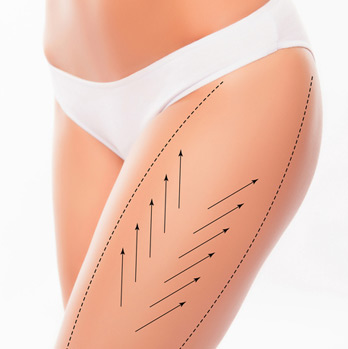
Patients who have managed to lose a significant amount of weight can become frustrated by the appearance of excess redundant skin. Significant weight loss is becoming much more common due to bariatric surgery (e.g. Gastric bypass) and the use of weight loss medication such as Ozempic. Just as some women have excess abdominal skin after one or more pregnancies, many patients who undergo significant weight loss have excess skin in the areas of weight loss. This can occur in any area that was affected, including the neck, breasts, arms, back, abdominal wall, hips, and legs.
There are several procedures that are helpful in treating this condition. A neck or a face lift can reduce excess folds of skin around the face or neck; a breast lift can be extended to the sides and back to help eliminate excess skin in those areas; a tummy tuck (abdominoplasty) is frequently required, sometimes with extension to the back.
Techniques originally devised to rejuvenate the upper arms can be used to eliminate the excess skin that can occur following significant weight loss. Likewise, thigh lifts can be used to improve the appearance of the legs.
Benefits of Body Contouring After Weight Loss
Body contouring after weight loss offers numerous benefits, including the removal of excess, sagging skin, which can improve physical comfort and hygiene. These procedures enhance the body’s appearance, leading to a more proportionate and toned physique. Patients often experience a significant boost in self-confidence and body image. Additionally, body contouring can improve mobility and make it easier to engage in physical activities. The results are long-lasting, provided the patient maintains a stable weight, and contribute to an overall improved quality of life post-weight loss.
How Body Contouring After Weight Loss Is Done
Body contouring after weight loss typically involves multiple procedures tailored to the patient’s needs. Common surgeries include abdominoplasty (tummy tuck), thigh lift, arm lift (brachioplasty), and breast lift. These procedures are performed under general anesthesia. The surgeon makes incisions in strategic locations to remove excess skin and fat and tighten the underlying tissues. The skin is then repositioned and sutured for a smoother, more contoured appearance. Each procedure targets specific areas, and they may be performed in stages or combined in a single session, depending on the extent of correction needed.


Who Body Contouring After Weight Loss Is For
Body contouring after weight loss is ideal for individuals who have achieved significant weight loss and are left with excess, sagging skin. Candidates should be in good overall health, at a stable weight, and committed to maintaining their weight long-term. This surgery is suitable for those who have completed their weight loss journey, whether through diet and exercise or bariatric surgery. Ideal candidates have realistic expectations about the outcomes and understand that while body contouring can improve shape and contour, it is not a substitute for weight loss or a cure for obesity.
Surgical Process
The treatment process for body contouring after weight loss begins with a thorough consultation with a plastic surgeon. During this consultation, the surgeon assesses the patient’s health, discusses their goals, and determines the most appropriate procedures. Preoperative instructions may include lifestyle adjustments such as quitting smoking and avoiding certain medications. On the day of surgery, the patient undergoes general anesthesia. The surgeon performs the chosen procedures, which may include removing excess skin and fat and tightening underlying tissues.



Q: How long is the recovery period?
A: Recovery will vary depending on the type of procedures performed and the number of incisions made.
Q: Are there risks involved?
A: Risks include infection, blood clots, heavy bleeding, and complications from anesthesia.




